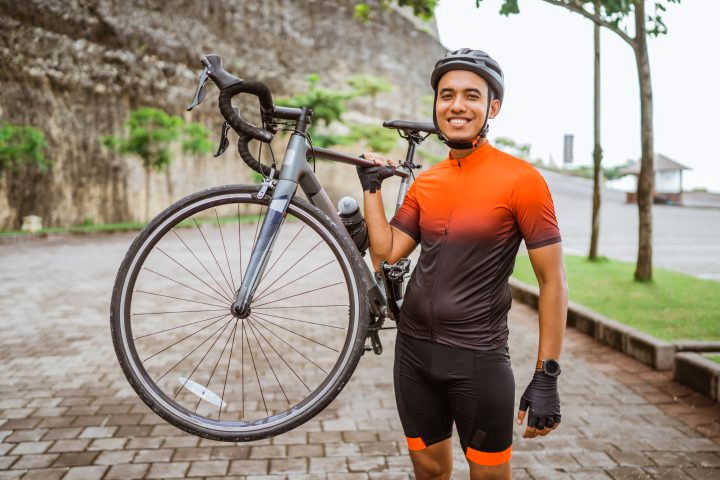
Cycling continues to increase in popularity and while regular cycling can bring many health benefits, it can also be challenging on the body. It is not uncommon for patients to visit a chiropractic clinic with cycling related problems. Some of these problems are a direct result of an accident. However, the underlying cause of many of the cycling related problems that chiropractors treat are related to the stresses and strains placed on the body when cycling. Many of these problems could have been avoided if the patient had taken precautionary steps.
In this post, a chiropractor identifies the most common types of cycling injuries and the seven steps cyclists should take to avoid them.
COMMON CYCLING INJURIES
LOWER BACK PAIN AND NECK PAIN
As chiropractors are well regarded for treating back and neck pain, it is not surprising that many of the cyclists who visit our chiropractic clinic do so as they are suffering from back and neck pain.
Many of these cyclists can spend hours cycling in a hunched position. Being in this position for long periods can fatigue the back and neck muscles. The muscles will tighten as lactic acid builds in them, which increases the risk of strains and sprains. In turn, back and neck strains often result in additional pressure being placed on joints and nerves, which can lead to joint dysfunction and nerve problems in extreme cases.
ACCIDENT-RELATED INJURIES
Unfortunately, it is not uncommon for patients to visit our chiropractors suffering from accident-related cycling injuries. These patients often present with back, wrist or collarbone injuries.
PATELLAR TENDONITIS INJURIES
When pedalling hard, the knee and in particular the patellar tendon, is placed under a significant amount of strain. The patellar tendon is located at the front of the knee. It comes under a lot of stress due to the load generated by the quadriceps muscle on it. This stress can result in inflammation and micro tears.
ACHILLES TENDON INJURIES
Pedalling action, especially when undertaken for long periods of time, can cause strain on the Achilles tendon. Clipless pedal setup can also result in extra stress on the Achilles (for further explanation please call John or discuss with your bike shop assistant), this can eventually lead to inflammation, micro tears and tendonitis.
FOOT PAIN
Foot pain, including tingling or numbness, are other common symptoms experienced by cyclists. These symptoms often occur due to poor bike fit or poorly fitting shoes.
7 STEPS TO AVOID COMMON CYCLING INJURIES
#1 – GET A PROPER BIKE FIT
If you haven’t already had a bike fit, then do yourself a favour and organise one. A good bike fit should ensure you are positioned in the most ergonomic, comfortable, safe and efficient riding position. Being in this position should enable you to ride for longer with less risk of repetitive strain injuries.
#2 – AVOID GOING FROM ZERO TO hERO TOO QUICKLY
It’s natural to want to progress quickly, however, overdoing the hours of cycling too quickly all too often leads to unnecessary injuries. The body needs time to adjust and build up strength and stamina. Pace your progress and allow your body to become accustomed to riding your bike for longer periods of time without putting undue strain and stress and your body.
#3 – RECOVERY DAYS ARE YOUR FRIEND
It’s all too easy to get swept away with your cycling. It offers a great sense of freedom and can be a fun and social activity that takes you to new places. However, your body does need a rest to recover, especially as you increase your cycle rides and distances. Having recovery days ensures that your body will be at less risk of incurring injuries.
#4 – MIND YOUR BIKE POSTURE
A good bike fit will help improve your riding posture, however, you do still need to be mindful of your posture when riding your bike. A good cycling posture should find you keeping your body relaxed and your spine in a neutral position as much as possible. To avoid putting too much strain on your tendons, your knees should also be directly above the pedals.
#5 – FIND A SEAT THAT WORKS FOR YOU
Choosing a bike seat that suits you is a very personal thing. Riding on an uncomfortable seat, especially for a long period, is not a pleasant experience. Inevitably you will find yourself moving around to find an angle that is more comfortable and may end up in a position that puts strain on other parts of your body. Spending time looking for a seat that works for you is time well spent.
#6 – PLAN SAFE CYCLING ROUTES
There are plenty of hazards to encounter when cycling, from bumpy, badly maintained roads to speeding drivers driving too close to you. Whenever possible spend some time planning your route to try and avoid as many of these ‘dangers’ as possible and hopefully reduce your risk of suffering a crash injury.
#7 – VISIT A CHIROPRACTOR
A good chiropractor will be able to assess your musculoskeletal system and help improve any weaknesses that may exist.
